Senna tora

|
|
Senna tora Common Names: Sickle Senna, Sickle Pod, Tora, Coffee
Pod, Foetid Cassia, Ringworm Plant Scientific
Classification Kingdom: Plantae Phylum: Tracheophyta Class: Magnoliopsida Subclass: Rosidae Order: Fabales Family: Fabaceae Subfamily: Caesalpinioideae Tribe: Cassieae Subtribe: Cassiinae Genus: Senna Species: S. tora Synonyms: Cassia tora L., Cassia boreensis Miq., Cassia borneensis Miq., Cassia gallinaria Collad., Cassia humilis Collad., Cassia tora var. borneensis (Miq.) Miq., Cassia obtusifolia L. Morphological Description Senna tora is
an herbaceous annual or short-lived perennial plant, typically growing 30–90 cm
tall, occasionally reaching 1.2 m in fertile soils. It is characterized by a
foetid odor when crushed, a trait reflected in its common name. Its key
features include: · Stem: Erect, branched, glabrous, green to reddish-brown, often
foetid when bruised · Leaves: Alternate, pinnate, 5–10 cm long, with 2–4 pairs of obovate
leaflets, 1.5–5 cm long, 1–2 cm wide, rounded at the apex, sensitive to touch · Flowers: Small, yellow, 1–2 cm wide, with five petals and ten stamens
(three staminodes), borne in pairs or short axillary racemes of 2–5 flowers · Fruit: Sickle-shaped pods, 10–15 cm long, 0.5–1 cm wide, flat,
compressed, green turning dark brown, containing 20–30 small, glossy, dark
brown seeds in a sticky black pulp The plant’s
touch-sensitive leaflets and distinctive pods aid identification, while its
foetid smell distinguishes it from similar species like Senna obtusifolia (Fern, 2024). Distribution and Habitat Senna tora is
pantropical, with a likely native range in Central America, though it has
naturalized across tropical and subtropical regions globally, including Africa
(e.g., Nigeria, Ghana, Kenya, South Africa), Asia (e.g., Afghanistan, India,
China, Pakistan, Myanmar, Nepal, Bhutan), the Americas (e.g., southern U.S.,
Caribbean, South America), and northern Australia. It thrives in: · Ecosystems: Lowland wastelands, riverbanks, roadsides, forest edges, and
agricultural fields (altitude 0–1,400 m) · Climate: Warm, humid tropics (20–35°C), rainfall 500–2,000 mm
annually · Soils: Well-drained, sandy to loamy, tolerating drought and partial
shade Ethnopharmacology Senna tora,
also known as Cassia tora or sickle senna, is a leguminous plant widely
recognized in traditional medicine for its diverse therapeutic properties.
Various parts of the plant, including leaves, seeds, and roots, have been
utilized to address multiple health conditions. The seeds are renowned for
their laxative effects, aiding in alleviating constipation and promoting
regular bowel movements. Traditionally, the leaves and seeds have been applied
to treat skin ailments such as ringworm, eczema, and scabies, attributed to
their antimicrobial and anti-inflammatory activities. The leaves have also been
employed in managing liver disorders, suggesting hepatoprotective effects. Phytochemical
analyses have revealed that Senna tora contains bioactive compounds with
antioxidant and antimicrobial properties, contributing to its therapeutic
potential. In traditional Chinese medicine, the seeds are consumed in infusions
to support eye health and improve vision. Additionally, the plant has been
traditionally used to alleviate inflammation, supporting its role in managing
inflammatory conditions. These medicinal properties underscore the significance
of Senna tora in traditional healing practices and highlight its potential for
further pharmacological research and therapeutic applications. · Antimicrobial: In Nigeria, leaf extracts inhibited Staphylococcus aureus (MIC 64 µg/mL) and Escherichia coli (MIC 32 µg/mL), supporting skin infection
treatment (Mongalo et al., 2015). · Anti-inflammatory: Ononitol Monohydrate: This compound,
isolated from Cassia tora leaves, has demonstrated significant
anti-inflammatory and analgesic activities in animal models. In experiments
involving male Wistar rats and mice, ononitol monohydrate effectively reduced
inflammation in carrageenan-induced paw edema and croton oil-induced ear edema.
Additionally, it alleviated pain responses in acetic acid-induced abdominal
constriction and formalin-induced paw licking tests, indicating both peripheral
and central analgesic potential (Antonisamy, 2017). · Skin Diseases: Has Anti-Fungal properties; Formulations containing
methanolic extracts of Cassia tora leaves have shown significant reduction in
psoriasis indicators in animal models. (Singhal, 2012). · Vision Improvement: In Korea, seed tea (Jue Ming Zi) is used
for eye health. · Hepatoprotective: n in vivo study, ononitol monohydrate isolated
from Cassia tora decreased the levels of serum transaminase, lipid peroxidation
and TNF-alpha but increased the levels of antioxidant and hepatic glutathione
enzyme activities. Compared with reference drug silymarin ononitol monohydrate
possessed high hepatoprotective activity. Histopathological results also
suggested the hepatoprotective activity of ononitol monohydrate with no adverse
effect. Hence we conclude that ononitol monohydrate is a potent
hepatoprotective agent (Dhanasekaran et al., 2009). ⚠ Toxicity Profile: Excessive consumption (>1 g/kg) may cause gastrointestinal
distress (e.g., diarrhea, cramps) due to anthraquinones. Subchronic studies
show an LD₅₀ of ~2,500 mg/kg in rats, with no significant adverse effects at
2,000 mg/kg/day over 13 weeks; however, prolonged use risks hepatotoxicity.
Caution is advised, especially in pregnancy (Lee et al., 2019). Additional Uses · Culinary: Young leaves are cooked as a vegetable in Nigeria and India;
roasted seeds serve as a coffee substitute in Sri Lanka (Fern, 2024). · Industrial: Seeds yield galactomannans (CT gum), used as a thickener in
textiles, pet food, and mining industries, with India as a key producer (Van
Wyk et al., 2009). · Agricultural: Acts as a natural pesticide in organic farming, repelling
pests like aphids with volatile compounds. · Ecological: Stabilizes soil in disturbed areas and supports pollinators,
though it can become invasive. References
External Links More Pictures |
|
| Compounds of Senna tora |
|
| References |